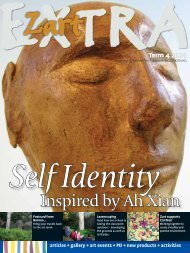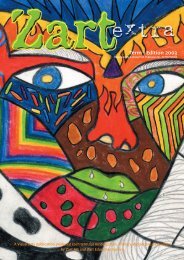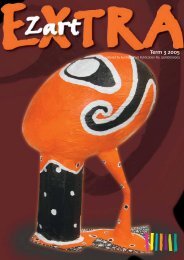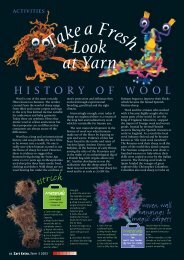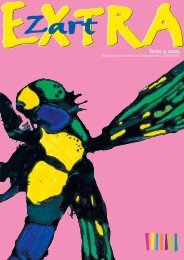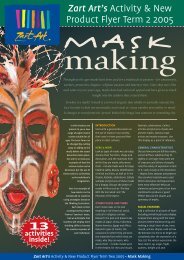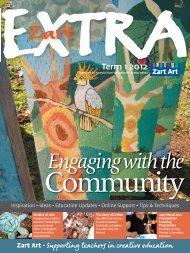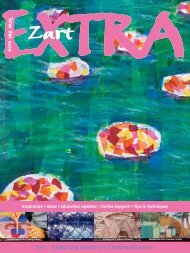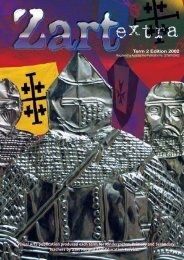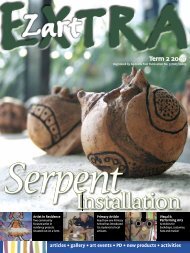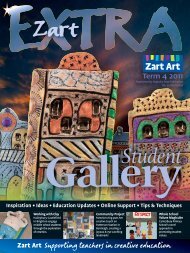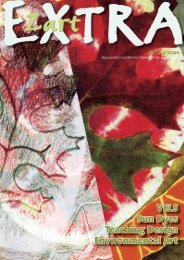Create successful ePaper yourself
Turn your PDF publications into a flip-book with our unique Google optimized e-Paper software.
DREAMER Steps This flyer offers you step-bystepinstructions only as a you to the DREAMER steps todoll. In this flyer we introduceguide to decorating dolls. Use teaching <strong>Art</strong>. DREAMER standsthe different techniques to for Discussion, Research,dress and embellish in your Experiment, <strong>Art</strong> Making,own way. There is a multitude Exhibit and Response.of media available to enable Currently in Australia, eachthe student to construct and state has its own curriculumdress a creative and unique guideline that comes with aunique language andformatting style. Moreoverthese curriculum guidelinesare under constant review andchange. DREAMER is ourinitiative to create a commonlanguage among teachers in arteducation. We hope it will standthe test of time and we wouldThe DREAMER steps to Doll Making:D discussion R research E experimentDiscussion is the first of theDreamer steps and it isinitiated through questionsthat will encourage studentsto share their knowledge ofcountries that may be linkedto their own heritage orpersonal experiences.Students share what theyknow and ask questionsabout what they want toknow.At this step students find outthe answers to the questionsthey have asked. Research onthe dolls from other lands isa starting point for studentsto delve into other aspects ofthat culture, such as, thestructure of society (eg. was itonly the wealthy who couldafford a doll?), the religioussignificance of dolls, thenatural resources available tothe people of that culture.Students also discover moreabout the national costumeor clothing of a particularcountry or region. Theyresearch and collateinformation about the clothing,the differences between menand women’s costumes, fabrictypes, accessories etc. Whenwas/is the costume worn? Forwhom? By whom? They collectpictures of the costumes;make sketches of particularitems of clothing and elementsof decorative features. Basedon the research, studentsmay build up a visual recordof how a doll wearing thesetraditional costumes mightlook like.Doll making is a multimediaconstruction andthere are techniques, skillsand processes that have tobe learned, such as, joiningtechniques of differentmedia to achieve the desiredresults. Allow students timeto experiment with a varietyof media for different partsof the doll, such as, clothing,hair and facial features.© <strong>Zart</strong> <strong>Art</strong> 2007
© <strong>Zart</strong> <strong>Art</strong> 2007like to encourage you to use itin your art making classes. TheDREAMER steps should beundertaken with thoughtfullydirected questions, so that theteacher challenges thinking andharnesses creative outcomesfrom each individual. “Teachertalk” - or more precisely “teacherquestioning technique” plays ahuge role in determining howstudents are encouraged toachieve their individualpotential.Some doll making methods aremore demanding than othersand the teacher must be fullyaware of the students’ skill leveland interests when choosing anactivity from this brochure.Moreover, assessment should beon-going throughout thelearning experience, rather thanjust an evaluation of the finalartwork.N.B. Throughout this brochure we have included some DREAMER steps suggestions for each activity.AM art making E exhibit R responseThe steps taken prior to<strong>Art</strong> Making will allow thestudents to make informeddecisions about theirartwork and provide themwith the confidence tocreate a unique doll. Theymust remember to respectthe customs of otherpeople, but the desiredeffect and the overallimpression are in theirhands. Students willpresent their owninterpretations of whatthey see and know andthey will use dollconstruction techniques tomake, dress and embellishthe doll.Exhibiting the dolls maytake on a whole newmeaning if the results ofdiscussion, research andmedia experimentation areincluded. Visual Diaries mayrecord their findings and beworthy of viewing alongside the finished doll. Somethought needs to be given tothe exhibition space and thetype of audienceanticipated, for example,can the exhibition space beenhanced with draped fabricor boxes of varying heighton which to place the dolls?Should fabric samples beavailable for a sensoryexperience for those in theaudience who might bevisually impaired?Response to the artworkshould take on some form ofself-assessment. The processshould be discussed andthrough exchange of ideasand opinions students maylearn from their peers.Dolls shown here are from "Dolls - Around the World"
Uniforms1. Tear Rice Paper into small pieces and glue themon to the doll's arms and body. The arms will pullout of the holes to make this easier.2. Concertina fold a rectangle of Rice Paper andglue the folded paper around the base of thewooden figure.3. Glue a strip of Ribbon around where the foldedskirt joins the body.4. Curl Angel Hair around a Satay Stick and gluethe curled hair on to the doll’s head.5. Thread Pearls on to Beading Wire and securearound the neck of the doll to create a necklace.6. Thread Pearls on to Beading Wire and shape intoa tiara to place on top of the doll’s head.7. Create a handbag with a piece of Felt and SatinRibbon to hang on her arm.8. Use a fine pen to outline facial features on theface, add colour with markers or paint.QueenMaterials:Wooden Male on stand, WoodenFemale on stand, Felt, Satin Ribbon,Fur Fabric, Arbee Craft Glue, PMGlitter Paint Pens, Beads, Rice Paper,PVA, Angel Hair Silver, Satay Stick,Pearl Beads 4 mm, Beading WireThe ChefFor otherWooden Dolls seeOut nowDollsAround TheWorldA uniform is “the distinctiveclothing worn by members ofthe same organisation or bodyor by children attending certainschools”. Oxford DictionaryMake up a list of people whowear uniforms and discuss theadvantages of wearing auniform. Are they only worn forwork? Divide the list up intocategories eg. Work, sport andother groups.1. Paint a Wooden Toy Soldier inthe desired colour of the chosenuniform.2. Use Felt or other material toadd clothing to the doll, glue ortie the clothing around thewooden figure.3. Glue on Joggle Eyes and drawon the other facial features.4. Create tools of the trade, orsport that would help identifywhat the uniform is.5. Add any other part of theuniform or personal featuresmade from paper, card, wool orfabric.Materials:Wooden Toy Soldier, ChromacrylPaint, Felt, Joggle Eyes 5 mm,Permanent Marker, A4 CartridgePaper 125gsm, Armature Wire 1.6 mm,Arbee Craft Glue 250 ml, CardboardA4, Pearl Beads Black 4 mm© <strong>Zart</strong> <strong>Art</strong> 2007As seen inDollsOut nowAround TheWorldRDREAMER stepsResearchUse the Internet and books toresearch the life of the Britishroyal family and debate theadvantages anddisadvantages of being amember of this family.See also The NutcrackerChristmas book for more ideas.Did you know? The king of allballets, Tchaikovsky's TheNutcracker will be playing atthe <strong>Art</strong> Centre, State TheatreMelbourne in September of thisyear. Just in time for this year'sChristmas celebrations!RDREAMER stepsResponseWhat did the students find outabout different occupationsthroughout this study ofuniforms. Where did they findmost of the information andimages from, to help themwith their art making.www.zartart.com.au
TraditionalThe traditional or national dress of Korea is known as hanbok whichhas been worn by all ages since ancient times. The women's hanbokconsists of a wrap-around skirt and a bolero jacket. The men wear ashort jacket and baggy pants bound at the ankles. Traditionally thearistocratic class wore brightly coloured hanboks made of silkwhereas the commoners wore hanboks made with bleached hempand cotton, usually white or a pale colour.1. Cut a rectangle of colouredPolycotton approximately 44 x50 cm and the same sizerectangle of Tissue Silk.2. Lay the rectangle ofPolycotton on to the Tissue Silkand fold the two togetherlengthwise.3. Sew the short sides togetherto create a tube of fabric. Turnthe tube so that the sewn seamis inside the tube. Sew the twoopen edges together with astitch and gather it around theCalico Doll’s body just under thearms. Secure the skirt to thedoll’s body with a couple ofstitches at the back of the doll.MaterialsCalico Doll 25 cm, Felt, Tissue Silk,Polycotton, Merino Wool Tops,Polymark Paint Pens, Beads Pearl 4mm, Permanent Marker Black,Arbee Craft Glue 250 mLDDREAMER stepsDiscussionAsk the students what they wouldlike to know about Korea and invitea Korean to address the class with asmall presentation about growingup in Korea and adapting to life inAustralia.4. Create a bolero from arectangle of Felt foldedlengthwise. Cut away the fabricto create flared sleeves and ahole for the head to squeezethrough.5. Place the jacket over the headof the doll and glue the sideseams together. Decorate withstrips of Felt and Ribbon.6. Glue on Wool Tops for hair.Decorate with beads threaded onto a pin.7. Draw on facial features with apermanent black marker.8. Use Felt and Polymark PaintPens to create two slippers toglue on to the doll’s feet.KoreaKoreanDollDollFor otherCalico Dolls seeOut nowDollsAround TheWorldSouth AfricanNdebele RastaDollDolls made by different tribes in South Africacan depict the stages of women’s lives. Theycan range in size from 10 cm to 40 cm.Ndebele, Zulu and other South Africanwomen traditionally made Fertility Dolls toencourage fertility and to teach girls at thetime of their initiation into womanhood.They were secretly made for the bride by thematernal grandmother. It was consideredunlucky for the bride to keep the doll afterher third child was born.1. Paint a Poly People form with black paint andset aside to dry.2. Knot two lengths of Acrylic Wool together atone end and thread Pony Beads on to thelength and secure with a knot at the oppositeend. Repeat this for 5 or 6 dreadlocks/braids.3. Glue a line of Pearl Beads across the top ofthe Poly People head and down the centre ofthe face.4. Use Pearl Pins to stick two Star Beads in thehead for eyes.5. Wind Metallic Yarn around the body of thecone until half the body is covered in colour.6. Glue or pin a variety of Sequins around therest of the cone body.7. Pin the dreadlocks to the top of the head.Materials List:Poly People Kit, Metallic Yarn, Sequins, ChromacrylPaint Black, Acrylic Wool, Pearl Beads 4 mmCream, Pony Beads, Star Beads, Pearl PinsWorkshopsFor more information on thisand all other workshopsincluding bookings, pleasephone us on (03) 9890 1867 orrefer to our websitewww.zartart.com.auDolls - Around the WorldLevels: 3—5Date: Friday 11 May 2007Time: 9.20am—3.00pmConsultant: Deanne ClarkCost: $85.00Catering: A light lunch will be providedThis workshop is designed for teachers to learn newtechniques in creating basic doll foundations anddressing them in national costumes. It will providedoll-making activities for students of all ages. Thisworkshop is based on the publication Dolls Aroundthe World where we have undertaken a study of aworldwide collection of dolls - their history, culturalcontext, design features and purpose. See how eachbase may be adapted to create the doll of yourchoice using a variety of media.© <strong>Zart</strong> <strong>Art</strong> 2007www.zartart.com.au
cs_DollsCover_0906.indd 2-3 26/02/2007 3:15:55 PMFuturistic© <strong>Zart</strong> <strong>Art</strong> 2007DNew BookRelease!As seen inDollsOut nowAround TheWorldDREAMER stepsDiscussionDiscuss the concept ofsuperstitions and make up alist of common ones thatparents or grandparentsmight say. What is the originof some modernsuperstitions?This book has step-around the worldby-step instructionsfor 32 different dollsfrom around the world. They arepresented to inspire students of all agesto construct and dress a doll creatively.1. Paint the wooden stand silverand set aside to dry.2. Cut out cardboard triangles ofdifferent sizes to create the dressand back collar.3. Cover each triangle withAluminium Foil.4. Twist a Tinsel Stem aroundthe neck of the doll to create twoarms.5. Cover the Poly Body and armswith Aluminium Foil, pinning ifnecessary to secure it to thebody.6. Twist a Tinsel Stem around theneck and draw on a face.7. Cut multiple lengths ofMetallic Yarn and tie a knot inthe middle of the bunch tosecure it for the hair.MaterialsPoly Body with stand,Liquitemp Paint Silver,Aluminium Foil, CardboardA4, Sequins in a JarDiamonds, Metallic YarnSilver, Metallic Tinsel StemsSilver, Tinsel Curtain Silver,Lill Pins, Pearl Pins, Beads,Arbee Craft Glue 250 mLEDREAMER stepsExhibitCreate a space station on animaginary planet where thesespace dolls might live.Include buildings andmachinery that would makethe station look quitefuturistic.Dollsar art&lotearound the worldTechniques • Projects • Inspirations8. Glue the hair on to the headand decorate with beads andPearl Pins.9. Glue the triangles together toform a skirt and bodice, decoratewith Diamond Sequins.10. Decorate the collar for theback of the doll with DiamondSequins and glue the collar tothe back of the doll.11. Wind a Tinsel Stem aroundthe waist of the doll for a belt.12. Glue strands of a TinselCurtain to the sleeves for extradecoration.PersonSpaceFor anotherPolystyrene FormDoll seeOut nowDollsAround TheWorldSee also TheNutcrackerChristmasfor more dollideas.<strong>Zart</strong> <strong>Art</strong> Ph: (03) 9890 1867 Fx: (03) 9898 6527



